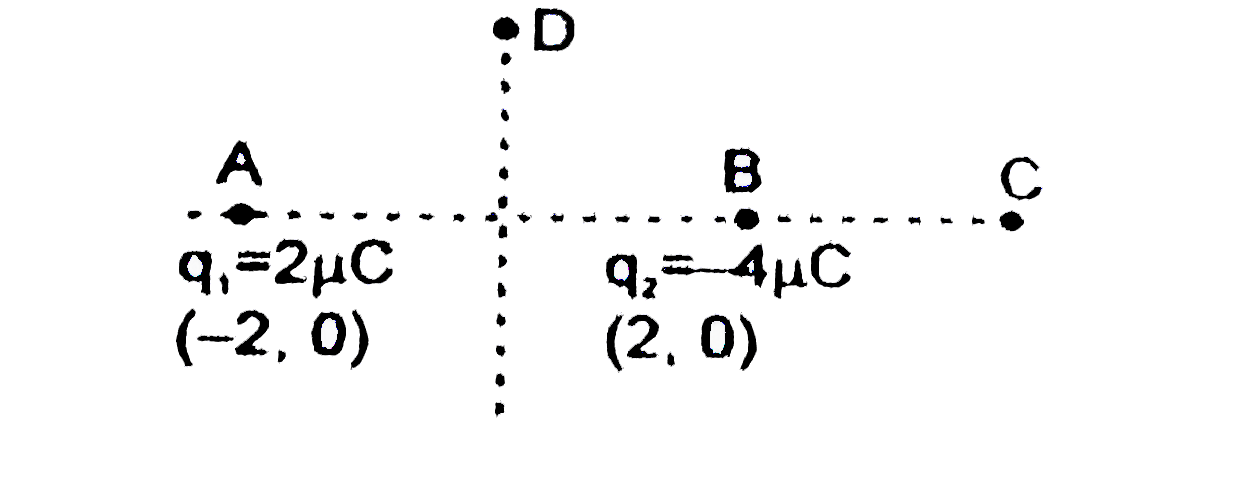Consider a spherical surface of radius 4 m cenred at the origin. Point charges +q and - 2q are fixed at points A( 2 m, 0,0) and B( 8 m, 0, 0), respectively. Show that every point on the shperical surface is at zero potential.
To show that every point on the spherical surface of radius 4 m centered at the origin is at zero potential due to the point charges +q at A(2 m, 0, 0) and -2q at B(8 m, 0, 0), we will follow these steps:
Step 1: Identify the coordinates of the charges and the spherical surface
- The charge +q is located at point A(2, 0, 0).
- The charge -2q is located at point B(8, 0, 0).
- The spherical surface is centered at the origin (0, 0, 0) with a radius of 4 m.
Step 2: Define a point P on the spherical surface
Let point P be any point on the spherical surface. Since the radius of the sphere is 4 m, the coordinates of point P can be represented as (x, y, z) such that:
x2+y2+z2=42=16
Step 3: Calculate the distance from point P to charge +q at A
The distance RPA from point P to charge +q at point A can be calculated using the distance formula:
RPA=√(x−2)2+y2+z2
Expanding this, we have:
R2PA=(x−2)2+y2+z2=(x2−4x+4)+y2+z2
Substituting x2+y2+z2=16:
R2PA=16−4x+4=20−4x
Step 4: Calculate the distance from point P to charge -2q at B
Similarly, the distance RPB from point P to charge -2q at point B can be calculated as:
RPB=√(x−8)2+y2+z2
Expanding this, we have:
R2PB=(x−8)2+y2+z2=(x2−16x+64)+y2+z2
Substituting x2+y2+z2=16:
R2PB=16−16x+64=80−16x
Step 5: Calculate the electric potential at point P
The electric potential VP at point P due to both charges is given by the formula:
VP=kqRPA+k−2qRPB
Substituting the distances we calculated:
VP=kq√20−4x−k2q√80−16x
Step 6: Simplify the potential expression
We can factor out kq:
VP=kq(1√20−4x−2√80−16x)
Step 7: Show that the potential is zero
To show that VP=0, we need to demonstrate that:
1√20−4x=2√80−16x
Cross-multiplying gives:
√80−16x=2√20−4x
Squaring both sides:
80−16x=4(20−4x)
80−16x=80−16x
This equation holds true, confirming that the potential at any point P on the spherical surface is indeed zero.
Conclusion
Thus, we have shown that every point on the spherical surface of radius 4 m is at zero potential due to the presence of the charges +q and -2q.
---
- The charge +q is located at point A(2, 0, 0).
- The charge -2q is located at point B(8, 0, 0).
- The spherical surface is centered at the origin (0, 0, 0) with a radius of 4 m.
Let point P be any point on the spherical surface. Since the radius of the sphere is 4 m, the coordinates of point P can be represented as (x, y, z) such that:
x2+y2+z2=42=16
The distance RPA from point P to charge +q at point A can be calculated using the distance formula:
RPA=√(x−2)2+y2+z2
R2PA=(x−2)2+y2+z2=(x2−4x+4)+y2+z2
Substituting x2+y2+z2=16:
R2PA=16−4x+4=20−4x
Similarly, the distance RPB from point P to charge -2q at point B can be calculated as:
RPB=√(x−8)2+y2+z2
R2PB=(x−8)2+y2+z2=(x2−16x+64)+y2+z2
Substituting x2+y2+z2=16:
R2PB=16−16x+64=80−16x
The electric potential VP at point P due to both charges is given by the formula:
VP=kqRPA+k−2qRPB
VP=kq√20−4x−k2q√80−16x
We can factor out kq:
VP=kq(1√20−4x−2√80−16x)
To show that VP=0, we need to demonstrate that:
1√20−4x=2√80−16x
√80−16x=2√20−4x
Squaring both sides:
80−16x=4(20−4x)
80−16x=80−16x
Thus, we have shown that every point on the spherical surface of radius 4 m is at zero potential due to the presence of the charges +q and -2q.
Topper's Solved these Questions
- ELECTROSTATICSBOOK - DC PANDEY ENGLISHCHAPTER - ELECTROSTATICSEXERCISE - Exercise 24.1
4 Videos
- ELECTROSTATICSBOOK - DC PANDEY ENGLISHCHAPTER - ELECTROSTATICSEXERCISE - Exercise 24.2
9 Videos
- ELECTROSTATICSBOOK - DC PANDEY ENGLISHCHAPTER - ELECTROSTATICSEXERCISE - Example Type 8
3 Videos
- ELECTROSTATIC POTENTIAL AND CAPACITORSBOOK - DC PANDEY ENGLISHCHAPTER - ELECTROSTATIC POTENTIAL AND CAPACITORSEXERCISE - (C) Chapter exercises
50 Videos
- GRAVITATIONBOOK - DC PANDEY ENGLISHCHAPTER - GRAVITATIONEXERCISE - All Questions
135 Videos
Similar Questions
Two point charges +q and -q are held fixed at (−a,0) and (a,0) respectively of a x-y coordinate system then
View SolutionTwo point charges q and –q are at positions (0,0,d) and (0,0, –d) respectively . What is the electric field at (a,0,0 ) ?
View SolutionTwo point charges q and –q are at positions (0,0,d) and (0,0, –d) respectively . What is the electric field at (a,0,0 ) ?
View SolutionTwo point charges of magnitude +qand−q are placed at (−d/2,0,0)and(d/2,0,0) are respectively. Find the equation of the euipotential surface where the potential is zero.
View SolutionTwo point charges −q and +q are located at points (0,0−a) and (0,0,a) respectively. The electric potential at point (0,0,z)is (Z>a)
View SolutionPoint charges +4q,−q and +4q are kept on the x-axis at points x=0,x=a and x=2a respectively, then
View SolutionTwo charges q1andq2 are placed at (0,0,d) and (0,0,-d) respectively. Find locus of points where the potential is zero.
View Solutiontwo point charges 2μC and −4μC are situated at points (−2m,0m) and (2m,0m) respectively. Find out potential at point C(4m,0m) and D(0m,√5m).

View Solution(i) Can two equpotential surfaces intersect each other ? Give reason.
(ii) Two charges +qand−q are located at points A (0,0,−2)andB(0,0,2) respectively. How much work will be done in moving a test charge from point P(4,0,0) to (−5,0,0) ?
View SolutionTwo point charge −q and +q/2 are situated at the origin and the point (a,0,0) respectively. The point along the X-axis where the electic field Vanishes is
View Solution
